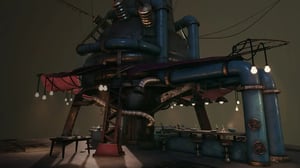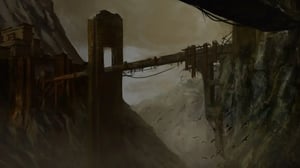
Environment Artist
Student work by Alexander Murdoch
TABLE OF CONTENTS
What does an environment artist do?
Working from concept art, real-world reference, and scans, environment artists create and lay out digital 3D environments — from compiling an entire set to scattering tiny rocks — that form the world of a film or video game. It includes populating an environment with assets, commonly known as set dressing. This role is commonly a specialization of an 3D modeler.
For films or TV shows, environments are often built, or extended, digitally when it is not possible or practical to film in real life (e.g. outer space, historical recreations, fantasy lands). Actors may be recorded against a green screen and their surroundings replaced by computer-generated environments built by 3D Environment Artists.
In video games, world building has an additional layer of complexity. The environments created must function and react according to the laws of physics and within the rules of the game universe. So characters must not be able to walk through walls, objects must react to gravity, etc. (unless these are unique features of the game universe).
3D environment artist job description
The stoic mountains framing the background of a game’s scene, the abandoned building you explore in search of supplies, even the ground your avatar walks on — all the modular pieces that make up the world of a film or game are the responsibility of an environment artist.
They are also commonly responsible for texturing and shading the environment assets they create, and when completed, are laying them out in the scene. Before building anything, environment artists must research and collate real-world references to map out the different aspects of a game’s geography.
CG Spectrum mentor of Virtual Production, Carl Shedd, defines world building and its importance in video games,
“World building can be as simple as subtle environmental storytelling, for example, a messy desk in an otherwise sterile bedroom, children's artwork on a refrigerator in a kitchen with a work coat draped over a dining chair, and a briefcase on the table. World building can be as significant as defining global traits for your fictional universe, elements of huge consequence!”
Role & responsibilities of an environment artist in the film and games:
- Producing high-quality organic (e.g., shrubs) and hard surface (e.g., buildings) models and texture maps in line with brief and reference material, including interpreting abstract ideas
- Presenting work in a turntable style environment with acceptable lighting for progress reviews and approval (including scale reference)
- Ensuring consistency of UV mapping and polygonal subdivisions
- Working closely with Design and Art Directors to ensure their geo (and textures maps) are working as they should be and addressing mesh fixes as required
- Optimizing the topology of assets in their scene so the environment runs at a manageable frame rate
- Mapping out scenery elements and props that help drive the story of the game

How much does an environment artist make?
The average Salary of a 3D environmental artist ranges from USD $51,00 to USD $91,000. (Source: Glassdoor)
Skills required to become a 3D environment artist
An environment artist must have a keen eye for landscape, cityscapes, town planning, and geography as these skills will be used to create virtual worlds within a film or game.
Game artists must also have the technical skills to understand whether a game engine can support low-resolution images in distant backgrounds and the limits of high-resolution images in the foreground.
While some junior positions are available in the industry, most environment artists have at least several years of 3D modeling, sculpture, and design. A good way to break into this field is to study 3D modeling and build up a portfolio of original 3D environment assets and set dressing pieces.
Film and game studios may look for the following skills in a 3D environment artist:
- Familiarity with the VFX pipeline or the game development pipeline (depending on chosen field)
- Strong knowledge of geography, architecture, and the laws of physics
- Experience processing and working with scans (Megascans, LiDAR scans, etc.)
- High-level drawing skills
- Able to interpret and follow reference material to create clean, detailed, and accurate 3D environments and sets
- Real-world understanding of proportion, depth, scale, and physical space
- Highly efficient UV layout experience using a UDIM workflow
- Ability to imagine expansive worlds that characters and objects can interact and move around in (video games specific)
What software and tools do 3D environment artists use?
Environmental artists work with various reference materials such as photography, geographical and political maps, architectural drawings, botanical elements, road structures, city planning layouts, etc.
3D environment artists may need knowledge of a combination of the following software:

Maya is a comprehensive 3D animation software used for creating detailed models, animations, and visual effects. It's popular in film, TV, and game development for its powerful tools.

3ds Max is a professional 3D computer graphics program for making 3D animations, models, games and images. It is developed and produced by Autodesk Media and Entertainment.

Blender is a free and open-source 3D computer graphics software tool set. It is used for creating animated films, visual effects, art, 3D-printed models, motion graphics, interactive 3D applications and virtual reality.

Unreal Engine is a 3D computer graphics game engine developed by Epic Games, first showcased in the 1998 first-person shooter video game Unreal

Maxon ZBrush is a digital sculpting tool that combines 3D/2.5D modeling, texturing and painting

Substance Painter: The tools you need to texture your 3D assets, from advanced brushes to Smart Materials.
A day in the life of a 3D environment artist
Working from concept art, real-world reference, and scans, environment artists help make a film or game more dynamic, constructing the overall realism of the story (even if done so stylistically), and assisting with world building.
With entertainment and technology veering towards augmented and virtual reality, and an increase in streaming services, the need for experienced 3D modelers will only rise.
How to become an environment artist
Increase your chances of getting hired with these strategies for success:
Download software
Try free 3D modeling programs like Blender, ZBrushCoreMini, or Houdini Apprentice. Otherwise, Autodesk Maya (industry standard) offers a free trial.
Build skills
Build the skills companies are listing on job sites. For more support, enroll in a reputable course. CG Spectrum’s courses include mentorship from 3D modeling pros and an industry-led curriculum.
Watch trends
Online tutorials, webinars, and events can help keep your skills fresh.
Network
Networking is vital. Familiarize yourself with the industry and build your community. Interact online and in real life with industry pros who might offer advice, insights, or job opportunities.
Intern
Internships at VFX or game studios can help you break into the industry. It’s one way to gain hands-on experience, network, and experience studio life.
Sell assets
Create and sell assets on Unreal Engine Marketplace or similar to gain exposure, get feedback, demonstrate skills to potential employers and collaborators, and make money!
Collaborate
Know a rigger or animator who’d like to bring your scene to life? Collaborating with peers is fun and can produce polished work for your reel.
Join contests
Practice your skills and create assets for your reel by participating in contests and challenges on sites like The Rookies, ArtStation, and 3Dtotal.
Share work
Social media is great for showcasing work, building an audience, having your work shared by others, and seen by potential clients and collaborators.

Ready to Start Your Film & Games Journey?
Download our course guide to see how we can help you on your pathway to your dream career.Tips to break into the industry as an environment artist
Additional resources to help you get started as a 3D modeler for film and games:
- Read What is 3D modeling?
- Recommended reading list for 3D artists by CG Spectrum Mentor Bryan Mentor
- Check out Altruism Digital’s YouTube channel
- Watch How to sell your assets on Unreal Marketplace
- Download free assets on sites like Unreal Engine Marketplace, ProductionCrate, MegaScans,
AbientCG, Sketchfab, and TurboSquid and see how other people build their models - Use Anatomy for Sculptors’ free 3D écorché reference tool
- Join the Autodesk community and check out all their forums
- Blender also has a bunch of great communities you can join
- Explore ArtStation’s and 3Dtotal’s free modeling tutorials
- Visit the official Maya, ZBrush, and Houdini learning channels on YouTube
Demo reel tips:
- Tailor your reel to the studio and role you’re applying for
- Include scale reference to show your model is at the correct scale
- Where possible, show your model moving (e.g., via a turntable or rigged animation)
- If textured, render your model under different lighting conditions
- Use Vimeo for best video quality, plus you can update your video
- Embed your reel on a platform (like ArtStation) with high-res stills of your model’s best angles
- No studio experience: keep your reel < 1 min. 1–2 years experience: < 2 mins Work in progress is fine, but only include your best models
- Ensure music doesn’t distract from your work
- Double-check for errors; then check again
- Get feedback from at least 3 mentors or industry pros before finalizing
- Include reference footage, breakdowns, and credits where relevant
- Specify if your model is for animation, VFX, or games (each has different requirements)
- Share your reel on your website, ArtStation, LinkedIn, and other social channels
- Include any production experience

Industry Pathways
Bryan Bentley, 3D Modeling Curriculum Manager at CG Spectrum, shares how he broke into modeling almost by chance, from landing his first internship at the Jim Henson company to working at ILM on the Oscar-winning film Rango. Throughout, Bryan has nurtured his love for education and life-long learning.


